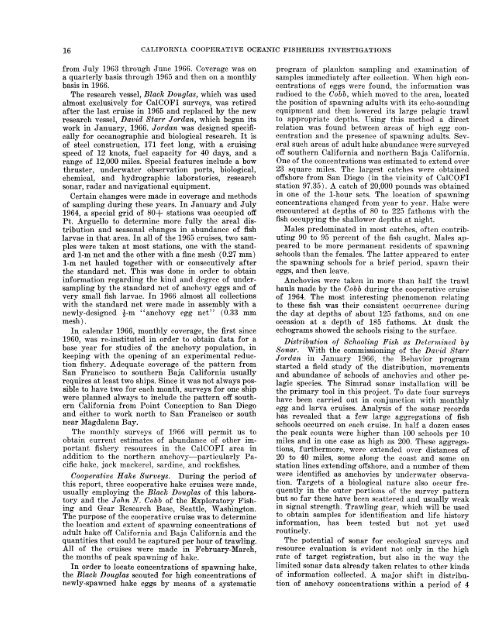CalCOFI Reports, Vol. 11, 1967 - California Cooperative Oceanic ...
CalCOFI Reports, Vol. 11, 1967 - California Cooperative Oceanic ...
CalCOFI Reports, Vol. 11, 1967 - California Cooperative Oceanic ...
Create successful ePaper yourself
Turn your PDF publications into a flip-book with our unique Google optimized e-Paper software.
16CALIFORNIA COOPERATIVE OCEANIC FISHERIES INVESTIGATIONSfrom July 1963 through June 1966. Coverage was ona quarterly basis through 1965 and then on a monthlybasis in 1966.The research vessel, Black Douglas, which was usedalmost exclusively for <strong>CalCOFI</strong> surveys, was retiredafter the last cruise in 1965 and replaced by the newreseasch vessel, David Xtarr Jordan, which began itswork in January, 1966. Jordan was designed specificallyfor oceanographic and biological research. It isof steel construction, 171 feet long, with a cruisingspeed of 12 knots, fuel capacity for 40 days, and arange of 12,000 miles. Special features include a bowthruster, underwater observation ports, biological,chemical, and hydrographic laboratories, researchsonar, radar and navigational equipment.Certain changes were made in coverage and methodsof sampling during these years. In January and July1964, a special grid of SO+ stations was occupied offPt. Arguello to determine more fully the areal distributionand seasonal changes in abundance of fishlarvae in that area. In all of the 1965 cruises, two sampleswere taken at most stations, one with the standard1-m net and the other with a fine mesh (0.27 mm)1-m net hauled together with or consecutively afterthe standard net. This was done in order to obtaininformation regarding the kind and degree of undersamplingby the standard net of anchovy eggs and ofvery small fish larvae. In 1966 almost all collectionswith the standard net were made in assembly with anewly-designed 3-m “anchovy egg net” (0.33 mmmesh).In calendar 1966, monthly coverage, the first since1960, was re-instituted in order to obtain data for abase year for studies of the anchovy population, inkeeping with the opening of an experimental reductionfishery. Adequate coverage of the pattern fromSan Francisco to southern Ba ja <strong>California</strong> usuallyrequires at least two ships. Since it was not always possibleto have two for each month, surveys for one shipwere planned always to include the pattern off southern<strong>California</strong> from Point Conception to San Diegoand either to work north to San Francisco or southnear Magdalena Bay.The monthly surveys of 1966 will permit us toobtain current estimates of abundance of other importantfishery resources in the <strong>CalCOFI</strong> area inaddition to the northern anchov3.--particularly Pacifichake, jack mackerel, sardine, and rockfishes.<strong>Cooperative</strong> Hake Xurveys. During the period ofthis report, three cooperative hake cruises were made,usually employing the Black Douglas of this laboratoryand the John N. Cobb of the Exploratory Fishingand Gear Research Base, Seattle, Washington.The purpose of the cooperative cruise was to determinethe location and extent of spawning concentrations ofadult hake off <strong>California</strong> and Baja <strong>California</strong> and thequantities that could be captured per hour of trawling.All of the cruises were made in February-March,the months of peak spawning of hake.In order to locate concentrations of spawning hake,the Black Douglas scouted for high concentrations ofnewly-spawned hake eggs by means of a systematicprogram of plankton sampling and examination ofsamples immediately after collection. When high concentrationsof eggs were found, the information wasradioed to the Cobb, which moved to the area, locatedthe position of spawning adults with its echo-soundingequipment and then lowered its large pelagic trawlto appropriate depths. IJsing this method a directrelation was found between areas of high egg concentrationand the presence of spawning adults. Severalsuch areas of adult hake abundance were surveyedoff southern <strong>California</strong> and northern Baja <strong>California</strong>.One of the concentrations was estimated to extend over23 square miles. The largest catches were obtainedoffshore from San Diego (in the vicinity of <strong>CalCOFI</strong>station 97.35). A catch of 20,000 pounds was obtainedin one of the 1-hour sets. The location of spawningconcentrations changed from year to year. Hake wereencountered at depths of SO to 225 fathoms with thefish occupying the shallower depths at night.Males predominated in most catches, often contributing90 to 95 percent of the fish caught. Males appearedto be more permanent residents of spawningschools than the females. The latter appeared to enterthe spawning schools for a brief period, spawn theireggs, and then leave.Anchovies were taken in more than half the trawlhauls made by the Cobb during the cooperative cruiseof 1964. The most interesting phenomenon relatingto these fish was their consistent occurrence duringthe day at depths of about 12.3 fathoms, and on oneoccasion at a depth of 185 fathoms. At dusk theechograms showed the schools rising to the surface.Distribution of Schooling Fish as Determined bySonar. With the commissioning of the David XtarrJordan in January 1966, the Behavior programstarted a field study of the distribution, movementsand abundance of schools of anchovies and other pelagicspecies. The Simrad sonar installation will bethe primary tool in this project. To date four surveyshave been carried out in conjunction with monthlyegg and larva cruises. Analysis of the sonar recordshas revealed that a few large aggregations of fishschools occurred on each cruise. In half a dozen casesthe peak counts were higher than 100 schools per 10miles and in one case as high as 200. These aggregations,furthermore, were extended over distances of20 to 40 miles, some along the coast and some onstation lines extending offshore, and a number of themwere identified as anchovies by underwater observation.Targets of a biological nature also occur frequentlyin the outer portions of the survey patternbut so far these have been scattered and usually weakin signal strength. Trawling gear, which will be usedto obtain samples for identification and life historyinformation, has been tested but not yet usedroutinely.The potential of sonar for ecological surveys andresource evaluation is evident not only in the highrate of target registration, but also in the way thelimited sonar data already taken relates to other kindsof information collected. A major shift in distributionof anchovy concentrations within a period of 4















